AI Strategies for Building a Skills Based Organisation
Building a skills-based organization can significantly enhance agility and competitiveness, but many organizations face challenges in implementing this approach. Managing a clear skills inventory and overcoming cultural resistance can seem overwhelming, especially as the business landscape evolves with digital transformation and AI advancements.
The skills gap is a major issue, with 66% of large UK businesses struggling to find candidates with the necessary skills, and 35% facing intense job market competition. By 2030, an estimated 20% of the UK workforce will be significantly underskilled for their jobs, making it crucial for organizations to adapt and refine their talent management strategies.
In this article, we explore common challenges and offer practical strategies to help your organization transition smoothly to a skills-based approach, leveraging AI and other advanced technologies to stay competitive and future-ready.

Author: Grant Telfer
Business Development Director
Building a Skills-based Organization:
Common Challenges Faced
Lack of clear skills inventory and inefficient data management
One of the biggest hurdles is not having a clear understanding of the skills within your organization. Data is often siloed in various departments and systems, making it difficult to get a unified view. Without a comprehensive skills inventory, identifying gaps or areas for development is challenging, leading to inefficient talent management.
Complexity of building and maintaining a skills landscape
A skills landscape categorizes and defines the skills needed in your organization, helping to identify and develop talent. However, building and maintaining this framework is complex and resource-intensive, requiring continuous updates to reflect market and organizational changes.
Resistance to change
Cultural resistance is another major barrier. Employees and managers used to traditional ways of working may resist the shift to a skills-based approach, fearing it will disrupt routines. This resistance often comes from a lack of understanding of the benefits, fear of the unknown, and concerns about job security. Overcoming this requires clear communication, involving employees in the process, and providing training and support.
How to Apply Skills in Different HR Areas with AI
Despite these challenges, transitioning to a skills-based organization is achievable with the right strategies. Leveraging AI can streamline this transition, offering practical and actionable solutions for various HR functions. Here’s how you can apply skills in different areas of HR using AI.
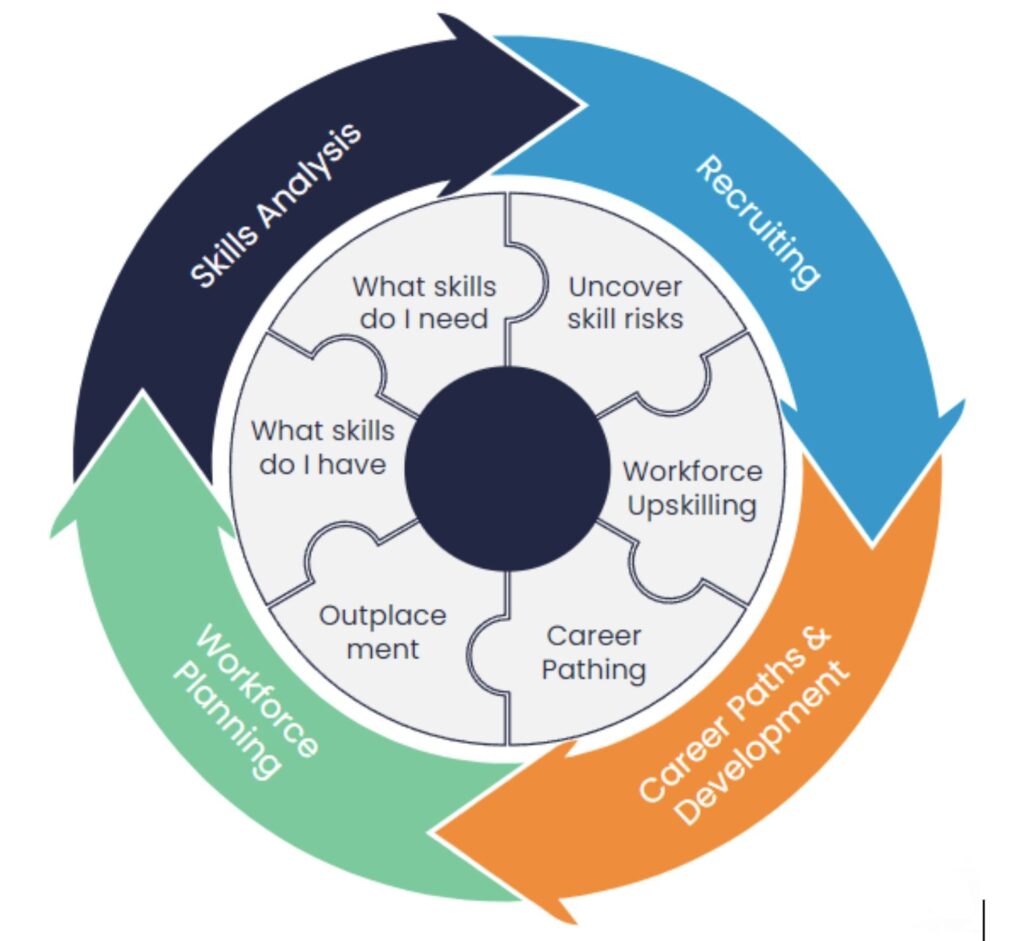
1) Start with a skills analysis
Effective skills analysis is the cornerstone of a skills-based organization. Begin by defining the objectives of your skills analysis. Are you looking to identify skill gaps for future workforce planning, improve recruitment, or enhance employee development? Clearly defining your goals will help guide the process and determine the scope of the audit.
Collect Data from Multiple Sources
Start by using AI technology to extract and consolidate existing HR data, such as employee profiles, CVs, performance appraisals, and other records. This approach leverages the wealth of information already available within your organization to build a comprehensive picture of each employee’s skills and the overall skills inventory.
If additional insight is needed, consider incorporating employee self-assessments to list skills, rate proficiency, and highlight development goals. Manager evaluations can add another layer of validation. Utilize HR records like job descriptions, performance reviews, training records, and certifications to further enrich your understanding of the organization’s skills landscape. This method ensures you make the most of the data you already have while maintaining a comprehensive and accurate skills inventory.
Create a unified skills language
After gathering this data, the next step is to create a unified skills language. This process involves structuring messy and scattered workforce data into an organized, coherent framework. By doing so, you can accurately assess the skills of your workforce, develop rich employee profiles, and identify skill gap.
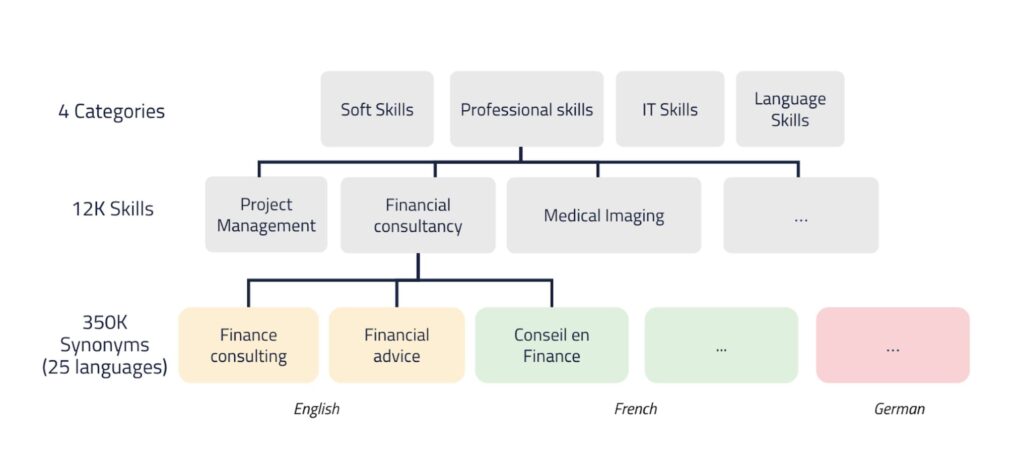
Map professions to specific skill sets
Next, AI-powered tools can map professions to specific skill sets, providing you a detailed analysis of these gaps. This mapping helps you discover related skills based on current roles, identify suitable professions for employees based on their skills, and reveal the ‘skills gap’ between any two professions.
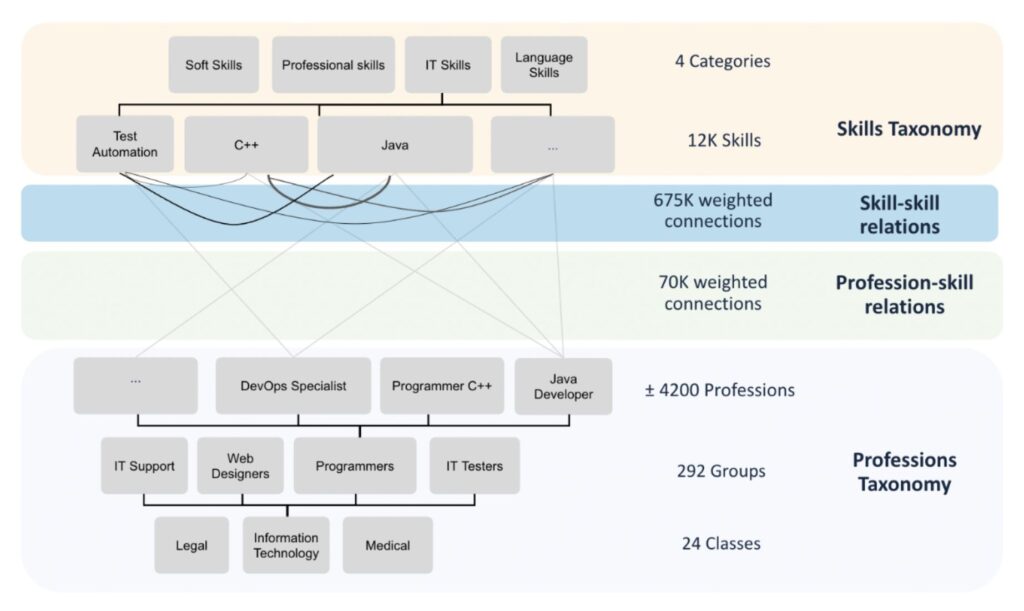
Create master job profiles
Finally, creating master job profiles based on both internal and external job data provides clear role responsibilities and career path clarity. This not only enhances career development but also ensures efficient and targeted recruiting.
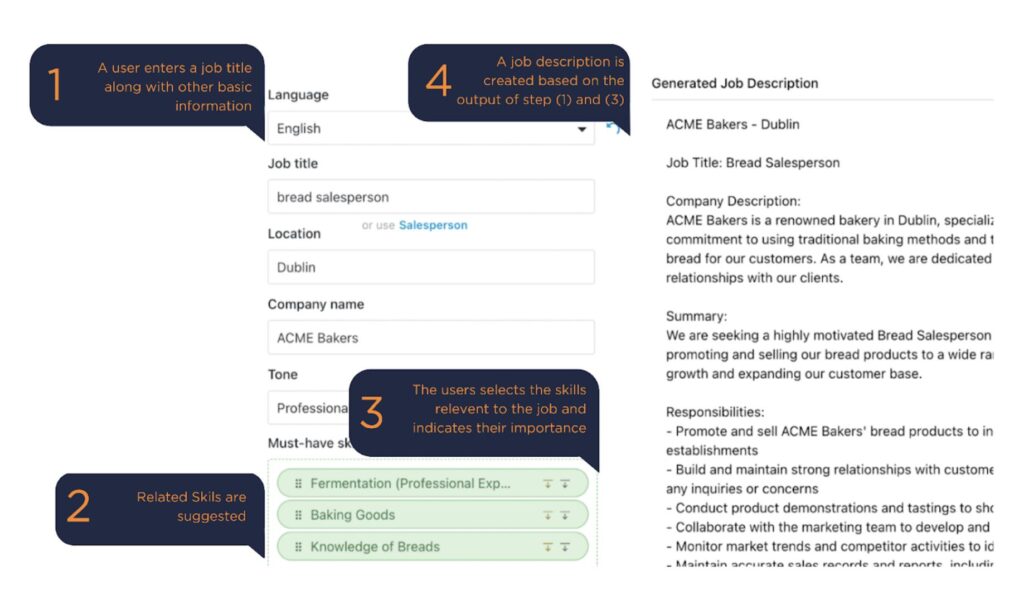
2) Enhance Recruiting with AI
Using AI, structure and normalize data from resumes, job ads, and other HR documents to create a rich data foundation. This allows for accurate skills matching and candidate profiling, setting the groundwork for efficient talent acquisition.
Automate routine task
Workflow automation further scales and grows your business by streamlining the recruiting process. AI can automate routine tasks such as resume parsing, candidate screening, and engagement, freeing up recruiters to focus on strategic activities.
For instance, AI can automatically shortlist candidates based on predefined criteria, send personalized engagement messages, and even schedule interviews. This automation not only saves time but also enhances the candidate experience by providing timely and relevant communication.
Create job descriptions that appeal to qualified candidates
Additionally, generative AI can revolutionize the creation of job descriptions. By analyzing job titles and basic role information, AI can suggest relevant skills and generate detailed, compelling job descriptions. This ensures that job postings are targeted and attractive to top talent.
For example, an AI tool can take a job title like “Project Manager” and suggest essential skills such as “project planning,” “team leadership,” and “budget management,” creating a comprehensive job description that appeals to qualified candidates.
3) Support Career Paths and Development with AI
AI plays a crucial role in this process by providing personalized career path recommendations and identifying suitable roles based on an employee’s skill set. By mapping current skills to potential career opportunities, AI helps employees visualize their growth within the company.
Bridge the skill gaps
This process involves creating rich employee profiles by assessing their skills, experiences, and career aspirations. AI then recommends preferred career paths, highlighting the skills needed for future roles and suggesting relevant learning content to bridge any skill gaps.
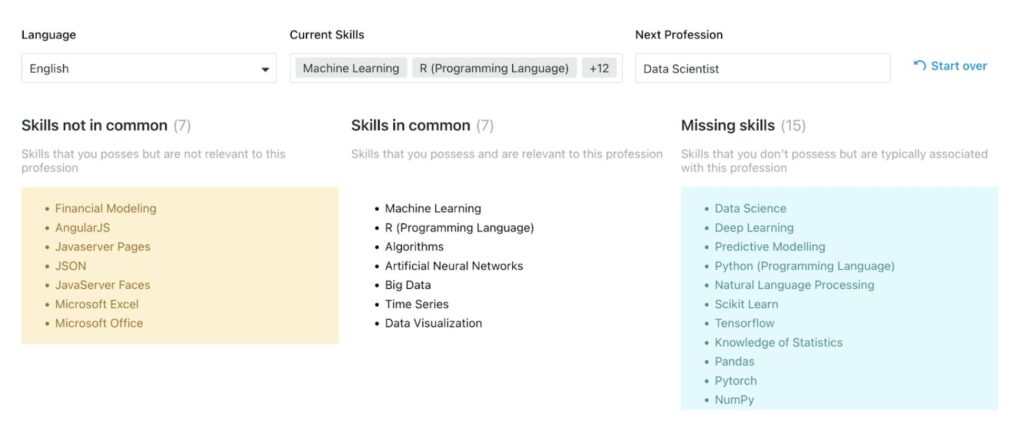
For example, if an employee aspires to move from a junior to a senior project manager role, AI can identify the necessary skills for this transition and recommend targeted training programs.
Promote internal mobility
Additionally, AI can help you identify skills to develop for other jobs within the company, promoting internal mobility and ensuring that your employees are well-prepared for new roles. This dynamic approach also includes suggesting mentors and networking opportunities, connecting employees with experienced colleagues who can provide guidance and support.
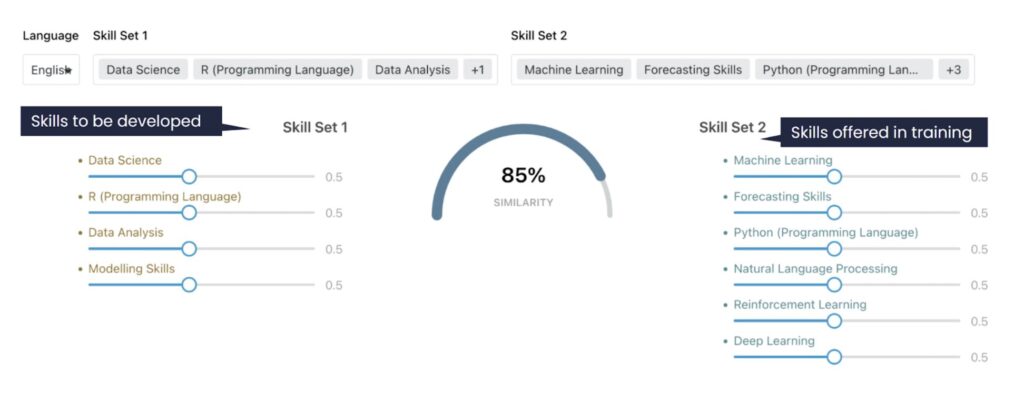
4) Strategic Workforce Planning with AI
Strategic workforce planning is the final area where you can apply skills. By leveraging AI, you can compare internal skills inventories with market demand, ensuring that you are prepared for future needs.
AI tools analyze real-time and historical demand data, identifying critical skills that are in high demand both internally and externally. This helps you to detect skill gaps and plan for future requirements effectively.
Predicting future job profiles
AI-driven workforce planning involves creating master job profiles that integrate internal data with external market insights. This ensures you that job roles are clearly defined, with explicit responsibilities and career paths, which aids in efficient and targeted recruiting.
For example, AI can help you analyze the skills of employees nearing retirement and predict the impact on the organization’s capabilities, enabling proactive measures to address potential shortfalls.
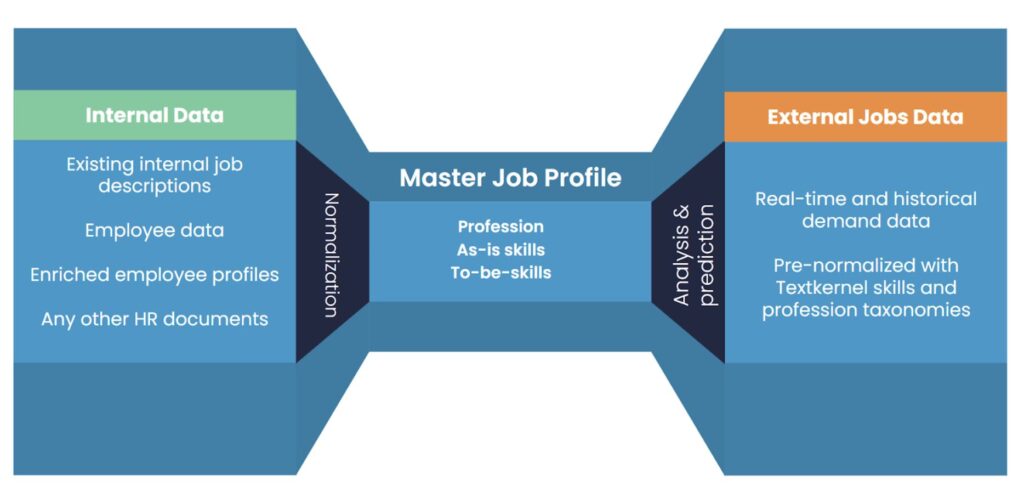
Salary trends and workforce composition
Furthermore, AI can provide you insights into salary trends and workforce composition, helping your organization stay competitive in the job market. By understanding what skills are most sought after and how competitors are hiring, you can adjust your talent strategies accordingly. This data-driven approach also allows for effective succession planning by identifying potential future leaders and ensuring they have the necessary skills and experience to step into critical roles.
Skills based organization: more agile, competitive and future-ready!
Building a skills-based organization enhances agility and competitiveness, but comes with challenges like managing a clear skills inventory and overcoming cultural resistance. By leveraging AI, you can streamline data management, automate recruiting, and personalize career development.
Start with a thorough skills analysis and create a unified skills language to understand and manage your talent better. Develop master job profiles and use AI-driven strategic workforce planning to address skill gaps and prepare for future demands.
Finally, embrace these strategies to create a more agile, competitive, and future-ready organization. Your journey to a skills-based organization starts now, and with these tools, you’ll be well-equipped to succeed.



